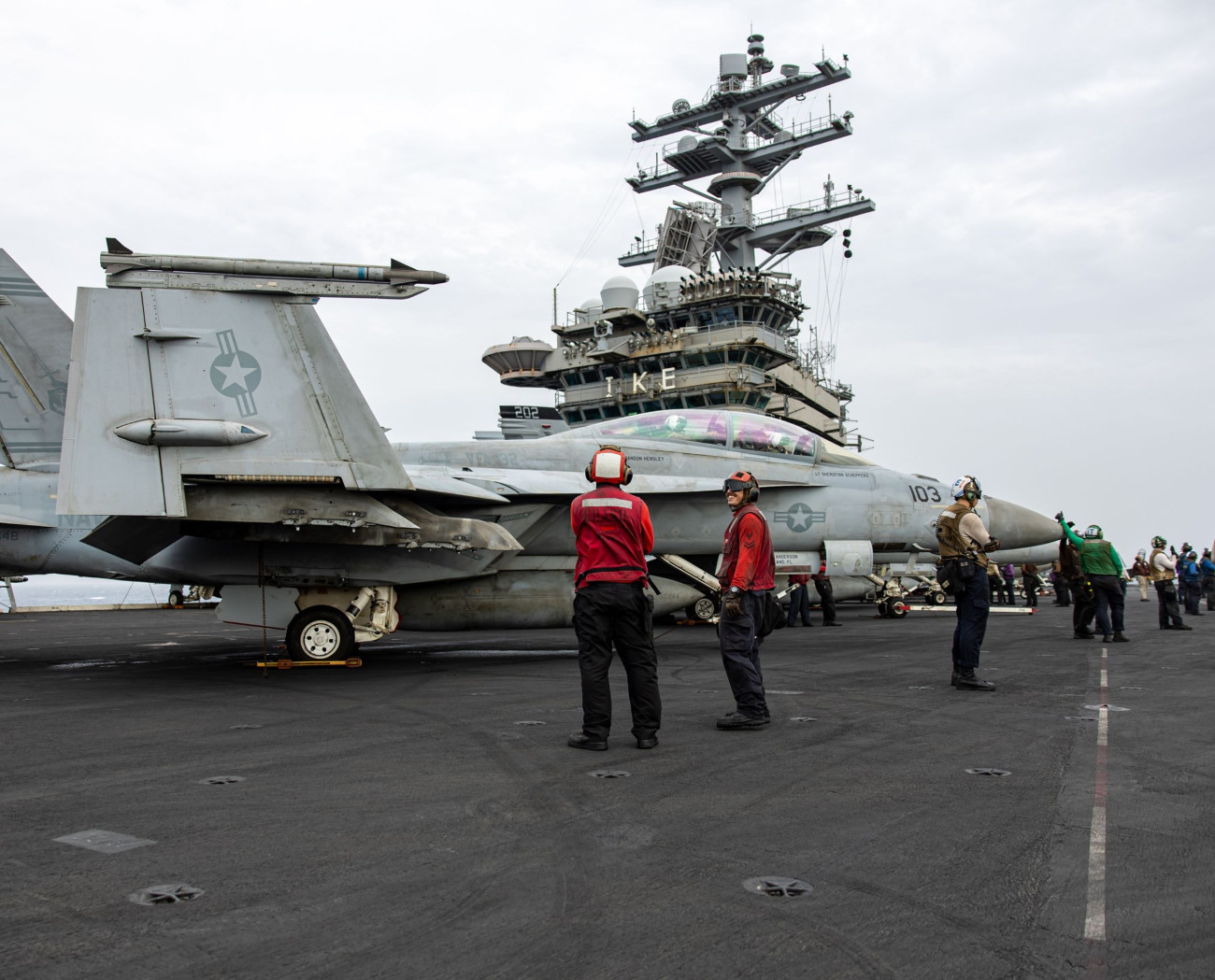

Introduction
The region remains on edge as Israel contemplates its planned retaliatory strike against Iran, while its wars in Gaza and Lebanon against the Iranian-backed groups Hamas and Hezbollah show few signs of concluding. Both sides’ now year-long effort to reassert deterrence over the other puts the United States in a challenging position — supporting its close regional allies and partners on the one hand, while working to deescalate the situation and prevent a region-wide war on the other.
How can America advance a new security and military strategy to safeguard the region from the threats posed by Iran, and what lessons have we learned over the past year of the US regional security approach? MEI has asked a group of security and US policy experts to weigh in on these and related questions.
This special feature is part of MEI’s strategic initiative on Iran.
Photo by Christopher Pike/Bloomberg via Getty Images
Viewpoints
-
Michael K. Nagata
Michael K. Nagata

Post-Oct. 7 shocks challenge America’s ability to contest still-multiplying security threats
As the complex tapestry of conflict across the Middle East continues, it will become increasingly difficult to sustain a sufficiently effective US presence in the region, but Washington must keep pace. At least three strategic vectors have converged to make this unwelcome reality so.
First, the United States is compelled to both help Israel because of their formal alliance, and because American credibility amongst other allies and partners would be profoundly damaged if it failed to do so.
Second, Iran has achieved the strongest strategic position it has enjoyed since its 1979 Islamic Revolution. Tehran now controls an unbroken strategic land bridge from Iran, through Iraq, Syria, and Lebanon, into the Mediterranean. And none of America’s regional allies, excepting Israel, have the strength or will to effectively confront Iran alone.
Third, the mayhem across the Middle East is providing rich opportunities for terrorists such as al-Qaeda and ISIS to recruit a new generation of adherents and pursue their ambitions to attack the US and its many allies across the region.
Where the US is reasonably well positioned, at least thus far, is in the provision of military assistance to Israel and other Middle Eastern allies. Most visible has been the large and continuing US military contributions to the defense of Israel and its role in protecting Red Sea shipping from attacks launched from Lebanon, Yemen, Iraq, Syria, or Iran itself. That said, the sophistication of such adversary threats and attacks continues to grow, which unavoidably requires even greater capabilities and efforts by the US.
Meanwhile, there are several very significant reasons for the US to be concerned and maintain a robust regional posture.
First, Iran and its proxies have proven they are all “learning organizations” and will continue to change and improve their methods of attack, whether kinetic or non-kinetic. Moreover, the easy availability of increasingly powerful commercial technology, which can be rapidly weaponized for military purposes, means Iran and its proxies will inevitably field increasingly capable weaponry and other sophisticated threats, in larger numbers, for the foreseeable future.
Second, Iran and its proxies are often proving more proficient, rapid, and aggressive in the “global debate of words and ideas” that has emerged because of all that has transpired since Oct. 7. This has undermined American credibility with populations both international and regional.
Third, Russia and China are incentivized to continue directly and indirectly nourishing any Middle Eastern actor trying to promote regional violence and instability. And so America is compelled to remain in because so many of its interests remain tied to this arena, even though this ties down large portions of US assets and thereby creates more freedom of action for Russian and Chinese malign activities globally.
Lt. Gen. (ret.) Michael K. Nagata is a Distinguished Senior Fellow on National Security at MEI. He retired from the US Army in 2019, after 38 years of active duty, with 34 years in US Special Operations. His final position was director of strategy for the National Counterterrorism Center from 2016 to 2019.
-
Katie Crombe
Katie Crombe

Integrated regional air defense proves its worth in the Middle East
As scholars and practitioners assess the lessons learned from the past year of interconnected conflicts in the Middle East, one lesson shoots to the top of the list — the importance of Integrated Air and Missile Defense (IAMD). While the United States attempts to navigate these overlapping crises through diplomacy, these efforts must be complemented by a defensive posture, including a regional security architecture, that protects Israel, partners, US troops, and interests in the region.
This regional air-defense architecture saw great success during the April 2024 Iranian attack, with limited damage and only one casualty from over 300 missiles and unmanned aerial vehicles (UAVs) launched — the largest combined ballistic missile, cruise missile, and drone attack in history. Defeating a barrage of missiles and UAVs from multiple vectors cannot be taken for granted. This was a combined effort, with contributions from multiple countries across the region as well as the US, United Kingdom, and France. Success emerged from years of deliberate training, interoperability exercises, European and regional partnerships, and Foreign Military Sales (FMS). US Central Command’s focus on partnerships as the backbone of a regional security architecture paid huge dividends in preparing for these multi-pronged attacks.
A pragmatic approach to regional security blends the differing but complementary capabilities of each country to create an umbrella of protection that all benefit from. At a time where the United States must be cognizant of its own defense readiness to respond to threats across the globe, our partners’ ability to capably defend themselves becomes critical. Traditional systems, coupled with joint investment in commercial technologies and artificial intelligence, can begin to close the air gap posed by increased and ubiquitous unmanned systems, returning advantage to the defender.
The need to maintain interoperability will persist in any future escalations. As we work to perfect the regional security architecture through an imperfect FMS system and a complicated landscape of bilateral and multilateral relationships, we must also augment air-defense systems in the near term. The United States’ recent commitment of a Terminal High-Altitude Area Defense (THAAD) Battery to Israel provides a near-term solution to the need to protect Israeli defenses at a range of altitudes. The THAAD system will sit alongside Israel’s air-defense systems to intercept short- to intermediate-range missiles at higher altitudes. Together, these systems will help to augment the capability of Israel’s air defenses in the event of another Iranian attack.
In an environment fraught with complexity, demonstrated protection of the airspace can prove critical in preventing an escalation spiral between Israel and Iran. A regional security architecture envisioned as omnipresent protection for the region is proving a realistic and worthwhile endeavor. In the future, as crises continue to emerge around the globe, the traditional air defenses of the United States will remain in high demand. The integrated air and missile defense seen in Israel and the Red Sea over the last six months proved formidable. We must ensure we do everything we can to maintain the FMS, interoperability, and partnerships required to help our partners maintain the safe skies necessary for peace and prosperity.
Col. Katie Crombe is a US Army strategist currently serving as the Chief, Joint Operational War Plans Division, The Joint Staff, J5. She is also a Non-Resident Scholar with MEI’s Defense & Security Program. The views presented herein are those of the author and do not necessarily represent the views of the Department of Defense.
-
Kevin Donegan
Kevin Donegan

The Iran-backed Houthis are clearly winning — what needs to be done?
Despite being battered, for nine months, by precision air attacks launched by forces of the United States and United Kingdom, along with absorbing retaliatory strikes by Israel, the Iran-backed Houthis have not just survived, they are thriving. This is not an arbitrary assessment; it is borne out by a host of metrics that show the Houthis are stronger and wield more influence now than they did before they began launching their attacks on Red Sea shipping lanes last October.
This is incredible given that the Houthis’ success in shutting down commercial energy and freight shipment through the Red Sea shattered a core US interest — maintaining freedom of navigation and the free flow of commerce — on which, in part, successive American presidents have based US Middle East policy.
The “tale of the tape” is clear — the Houthis are winning:
-
Despite a year of US and international efforts, the Red Sea remains closed to all major shipping lines.
-
The Houthis have absorbed potent US and UK precision attacks on launchers, weapons storage areas, targeting systems, command-and-control nodes, and their key port of Hodeida; and throughout this time, they never paused their attacks on commercial shipping, instead having extended their range and effectiveness.
-
They strengthened their supply lines to Iran that are needed for critical weapons components.
-
They are the only Iranian Axis of Resistance member to directly attack Tel Aviv with ballistic missiles and drones since the outset of the Gaza war, penetrating Israeli defense systems.
-
They have downed multiple US Reaper drones.
-
They have not backed down despite demands by the United Nations Security Council that they stop their attacks on ships.
-
They have successful pinned US forces to the Red Sea when those forces are needed to deal with developing hotspots and conflicts elsewhere.
-
They have gained prominence among the Iranian Axis of Resistance and are now advising Iranian proxies in Iraq.
-
Reporting suggests Russia may be providing them with more advanced weapons.
-
They have increased their capability to build weapons in Yemen.
-
The Houthis have strengthened their grip on power inside Yemen compared to before the Israel-Hamas conflict, when they struggled to recruit and were criticized for the failure to govern or feed the people living in the areas under their control.
So what is needed now from the US? The most critical necessity is leadership, with a clear mission and commitment. The Houthis are winning because the bar for them to do so is very low: they simply need to survive and absorb punishing attacks but remain resilient. They are not 10 feet tall; it is well within US capability to eliminate their ability to attack shipping.
But going forward, the US Navy cannot continue to put its sailors in harm’s way in the tight channel of the Red Sea and Bab el-Mandeb Strait with only seconds to defend themselves against incoming barrages of missiles and drones from Yemen. It is time for the US to lead the international community in what needs to be done — eliminate the Houthis’ grip on this vital international waterway.
The US successfully destroyed al-Qaeda in Yemen; and it did that with a fraction of the forces and treasure it is expending now. That success stemmed from having adopted a clearly issued intent to “destroy" al-Qaeda and the fact that this objective was carried out via a whole-of-government effort that included not just destroying the terrorist group’s military capabilities, but also disrupting their supply network, training infrastructure, financing, and most importantly eliminating their leadership. With the Houthis, US and allied forces are only attacking the arrows and doing little to destroy the broader network that provides the Yemeni group the capability to launch strikes on shipping; the most prominent omissions today are their supply chain from Iran and the Houthi leadership. The same clarity of mission and commitment is needed against the Houthis; they will not simply go away once the conflict in Gaza ends. This only becomes more important as additional disruptions to the global supply chain become likely as Israel and Iran trade punches.
Vice Admiral Kevin “Kid” Donegan (ret.) is the former commander of US Fifth Fleet, Naval Forces Central Command, director of operations at US Central Command, and commander of our forward deployed Carrier Strike Group based in Japan. He is currently a Distinguished Senior Fellow at MEI.
-
-
Robert S. Ford
Robert S. Ford

Withdrawal from Iraq and Syria won’t change Iranian threat
The withdrawal of American forces from Iraq in 2025 and 2026 will not have a big impact on Iran’s ability to use its proxies in Iraq and Syria to pressure neighbors. The small American force in Iraq has a counterterrorism and training focus. Its proximity to Iranian-backed “Islamic Resistance” militias makes it a target, not a tool against the militias.
Occasionally sharp American retaliation has given the militias pause in launching attacks against the Americans, but the respite has always been temporary. Iraqi government pressure, when applied, helps restrain the militias, as seen in recent months when Prime Minister Mohammed Shia al-Sudani pressed the militias to stand down while he negotiated a withdrawal deal with Washington. As Sudani and many Iraqi leaders want a sustained bilateral relationship with the United States, the best way forward is for them to divide and isolate the militias politically, as has happened during the last several months. Divisions among the militias themselves, and their sometimes-contentious relationships with Baghdad and even with Iran’s Islamic Revolutionary Guard Corps, further weakens the Iranian hand.
The threat of Israeli retaliation for militia attacks on Israel also weighs on the militias as well as Iraqi political leaders reluctant to fight Israel. After their transition to a bilateral assistance mission, the Americans will still maintain an ability to strike the militias from outside Iraq as a last resort, although such strikes cannot resolve the threat entirely. The militias in Iraq are a political, not military, problem. Iraqi nationalism, not Israeli or American airstrikes, is a better antidote to Iranian influence and penetration of Iraq.
If the US loses access to its logistics hub in Iraqi Kurdistan after the second phase of withdrawal from Iraq in 2026, the American military presence in Syria will conclude as well. The American forces operating in eastern Syria, with their counter-terrorism focus, cannot stop Tehran from supplying Iranian-backed militias in Syria. As in Iraq, the small American contingent has often been a target of Iranian proxy forces, and retaliatory strikes bring short-term relief but do not resolve the problem. In contrast to Iraq, President Bashar al-Assad’s weak government will not put any useful pressure on the Iranian militias operating in Syria. These militias will continue to threaten Israel and may even try to destabilize Jordan with illicit arms shipments (on top of the drug shipments they already facilitate). Israel, with American assistance, will have to maintain its watchful eye over Iranian-backed militias operating in Syria. The Americans and Israelis need to identify Iranian red lines, and the US must caution Israel about striking prudently lest it cross one of those Iranian red lines and set off a wider conflagration.
Amb. (ret.) Robert S. Ford is a Senior Fellow at the Middle East Institute, where he writes about developments in the Levant and North Africa.
-
Brian Katulis
Brian Katulis

America needs a regional diplomatic and political game plan on Iran to guide security measures
Iran’s Foreign Minister Abbas Araghchi traveled to Cairo last week to meet with Egypt’s President Abdel-Fattah el-Sisi. This visit was part of a weeks-long diplomatic blitz ahead of an anticipated retaliatory military strike against Iran by Israel. Notably, the top Iranian diplomat also recently made stops in Jordan, Lebanon, Syria, Saudi Arabia, Qatar, Iraq, Oman, and Bahrain.
Tehran’s focus seems to be a key center of gravity in the Middle East: Arab states that don’t share the exact same view as the United States and Israel about what’s happening in the region. Iran extracted a statement of neutrality in its ongoing conflict with Israel from the Gulf states earlier this month but clearly didn’t think this was enough because it pushed further, later threatening these same states with retaliation if they allow Israel to use their airspace to attack Iranian soil.
Where is America’s regional diplomatic effort to compete in this space? Crisis shuttle diplomacy by high-level administration officials aside, it’s been mostly absent, having accomplished little if anything to shape the calculations and actions of key Middle East countries since the war in Gaza began.
America’s recent military and security moves to address the threats from Iran and its regional proxies have been important but incomplete because what’s missing has been US statecraft that deploys these moves in a strategic context. The problem is not just an over-militarization of US strategy in the Middle East — something that has grown progressively worse in the two-plus decades since the 9/11 attacks. The biggest weakness is that the exercise amounts to fixating on tactics in the absence of an overall strategy on Iran that includes America’s regional partners.
In turn, brainstorming about various diplomatic solutions that, for instance, might prevent Israel from striking Iran or Iran from retaliating is important to do; but under the present conditions in the region, betting on the success of diplomacy absent other complementary policy options risks sounding academic and fanciful. Given the balance of interests and forces of the two main combatants, Israel and Iran seem poised for another round of conflict, and diplomacy alone has low odds of averting this outcome — though it would surely be a critical component of a potentially more successful multifaceted response.
A more practical regional approach for the United States would involve adopting two main steps.
First, the United States should empower the State Department to shift its regional diplomacy into higher gear on Iran. It is difficult to say what exactly the State Department does these days on Iran because much of the action seems centered either at the Pentagon, White House, or Central Intelligence Agency. This is not to say that the people working on Iran at the State Department are just sitting on their hands — it is just that the US approach to work with partners across the broader Middle East region has been absent for a long time. Indeed, even the last major diplomatic push on Iran, around the 2015 nuclear deal, mostly ignored the region and operated in the global framework of the P5+1 (the five permanent members of the United Nations Security Council plus Germany). America has lacked a strategic regional diplomatic approach to coordinate policy with Middle East partners, and not just Israel, on Iran for many years.
Understandably, the focus of the Biden administration’s efforts this year has been to try to modulate Israel’s response and prevent a regional war, but that doesn’t do much to prepare for what comes after the next round of conflict. This first step — of simply reaching out to US partners across the region, including those with which America closely cooperates militarily, and discussing the right diplomatic responses to the next likely round of Israel-Iran fighting is something that could be done immediately.
The second step is something that requires a multi-year approach and deeper engagement in the Middle East: stepping up US diplomatic and political efforts to strengthen the states vulnerable and susceptible to pressure and influence from Iran. This means, first of all, Iraq and Lebanon, where the US already has a relatively robust diplomatic presence on the ground. But it should necessarily also include other areas contested by Iran across the broader region, including Syria, Yemen, and Sudan, among other places, where the State Department’s footprint has been much lighter in recent years.
Today’s Iran presents a security threat to the region and, increasingly, other parts of the world if one includes, for example, its support for Russia’s invasion and illegal war against Ukraine. But it also presents a diplomatic and political challenge that the US would be in a better position to counter if only American diplomats were empowered to show up and make Washington’s presence felt.
Brian Katulis is Senior Fellow for US Foreign Policy at the Middle East Institute.
-
Ross Harrison
Ross Harrison

The US needs to help dispel illusions about Iranian and Israeli power
International relations theorists from the realist tradition argue that a struggle for power is the currency of international politics. But this presumption that all states seek to maximize their relative strength and influence offers little to clarify developments in the Middle East today, where illusions of power abound. In thinking through what a proper role for the United States should be as the region braces itself for the inevitable Israeli attack on Iran, we need to understand what illusions of power are harbored by the two protagonists and how Washington should work to clarify what the actual power dynamics are to encourage diplomacy.
Prior to the Oct. 7, 2023, attacks on Israel by Hamas, there were plenty of mistaken beliefs about Iranian power floating around. The entire region had bought into the notion that Iran was a regional hegemon with militias strewn across the weak and failed states of Lebanon, Syria, Iraq, and Yemen. Iran believed it itself, telling its own beleaguered masses and anyone who would listen that they had created a wall of deterrence against possible Israeli and American aggression.
Israel too harbored false impressions about its own power dynamics, assuming that it could assure its economic and security future by creating links with the Gulf Arab states through the Abraham Accords and wish away the hopes and ambitions of the Palestinians living under its control. It and its Arab partners both believed that the Palestinians lacked the political power to undermine these plans.
The year since the Oct. 7 attacks by Hamas on Israel has shone a light on both the Iranian and Israeli illusions about power, however. It clarified the fact that the Iranian formula for power was more rickety and less durable than previously thought. And it demonstrated that the idea of Palestinian self-determination was more powerful than Israel and the Arab states previously believed.
This clarification about power didn’t occur overnight. For much of the past year, it appeared that Iran was right about its own power edifice. All its militias, including Hezbollah, were activated to demonstrate that Israel was surrounded by a ring of hostility. This perception persisted as long as Hezbollah’s response fell short of full military support for Hamas. But when this war of attrition escalated into a full-blown conflict, and Hezbollah was partially disabled, it became clear that Iran’s perception of its power exceeded reality.
Israel’s power too has dissipated, but its perception hasn’t yet caught up to this fact. Even with Hamas decimated, and its leader Yahya Sinwar killed in action, Israel faces an existential struggle with Palestinian nationalism, which, if not resolved, will deny the country true security and prosperity. Among other limitations, failure to resolve the Palestinian issue will deny Israel the ability to multiply its power through expansion of the Abraham Accords to include Saudi Arabia.
What do these illusions about power tell us about a constructive role for the United States as Israel plans its attack on Iran? Reinforcing the reality that the power dynamics of both Israel and Iran have changed should be used to push both parties toward separate but related diplomatic tracks. The United States seems to have secured Israeli commitments to avoid attacks on Iran’s nuclear or energy facilities. It should also counsel Israel to adopt limited military objectives and avoid prolonged attacks. And it must consistently clarify that the only way Israel can secure its future and ensure the continued backing of the US is to commit to a two-state solution. The prospects of normalization of relations with Saudi Arabia could be the sweetener to ease downing what Israelis think of as the poison pill of yielding power to Palestinians in the West Bank and Gaza.
On the Iranian side, the United States should position itself to resurrect diplomacy after the conflict subsides, despite likely opposition from Israel. This can only happen if the next phase of the conflict with Israel is limited and short. Shorn of its perceived militia strength, Iran might see diplomacy as the only real option for creating regime and national security. We are already seeing Iran’s propensity for diplomacy in its stepped-up activity with the Gulf Cooperation Council (GCC) states. But if the Iranians feel that the US is doubling down on its support for Israel and establishing a permanent offshore balancing posture against the Islamic Republic, they could double down on their old approach and even make a run for a nuclear weapon.
We are at a point where the status quo satisfies neither the interests of Israel, nor Iran, nor the United States. Iran may believe it can restore the status quo ante by rebuilding Hezbollah, but it really can’t resurrect the deterrence it believed it had before Oct. 7 using its militias. The US must give it another pathway forward. In turn, Israel may be convinced that it can secure a better future by continuing to pummel Hamas, Hezbollah, and perhaps even Iran; but without resolving the Palestinian issue, that too is illusory. The US must reinforce for Israel that the only pathway forward is a process toward a two-state solution and condition American support on that. And it should work with the Saudis to reinforce that the only way to build on the Abraham Accords is through a commitment to the creation of a Palestinian state.
Washington should understand that the current moment is precarious. And so it must reinforce for Jerusalem and Tehran the adage that “force without diplomacy is reckless, and diplomacy without the possibility of force is feckless.”
Ross Harrison is a Senior Fellow and Book Series Editor at the Middle East Institute.











